Asus ROG Strix GL504 Hero II Review
Asus ROG Strix GL504 Hero II
A flashy gaming laptop with an ultra-smooth 144Hz display
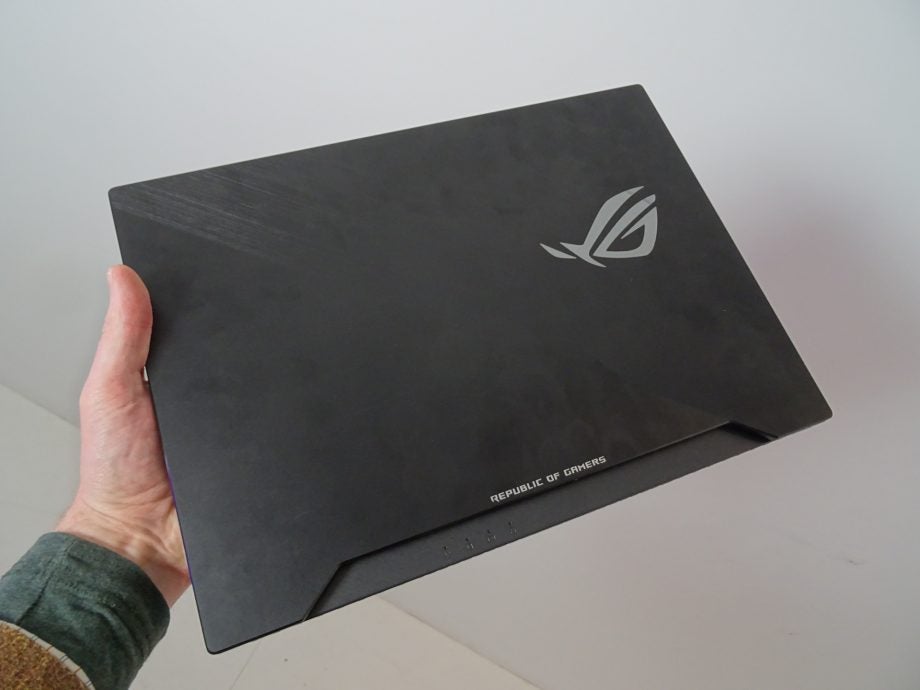
Verdict
One of the cheapest gaming laptops you'll find with a 144Hz display, but rival options offer superior performances for less cash
Pros
- One of the cheapest 144Hz gaming laptops around
- Multitude of RGB lighting options
- Keyboard and trackpad make for easy typing and browsing
Cons
- Outperformed by similarly priced laptops
- Struggles to cope with modern AAA games in Full HD
Key Specifications
- Review Price: £1500
- Nvidia GeForce RTX 1060 GPU
- Intel Core i5-8300H / i7-8750H
- 15.6-inch IPS Full HD (60Hz / 144Hz)
- Up to 1TB storage
- Weight: 2.4kg
What is the Asus ROG Strix GL504 Hero II?
The Asus ROG Strix GL504 Hero II is a gaming laptop that’s chiefly geared towards players of MOBA-type games such as Dota 2 and League of Legends, hence the QWER keys and a super-high 144Hz refresh rate display.
While the requirements of such games are typically less intensive than modern day blockbusters (which is the reason you get a lower-specced Nvidia GTX 1060 here), how does the ROG Hero II measure up against gaming laptops released over the past few months?
Related: Best gaming laptops
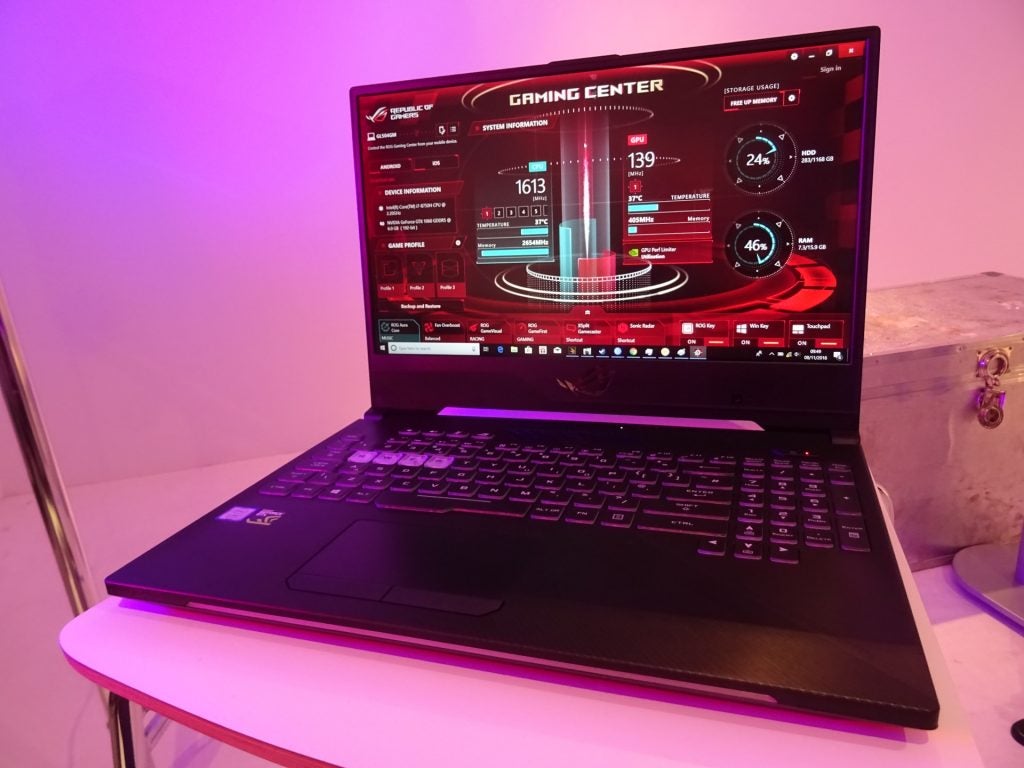
The ROG Hero II looks every inch the party piece.
Asus ROG Strix GL504 Hero II – Design and features
Style-wise, the Asus ROG Strix GL504 Hero II is typical of a gaming laptop. It’s all black with red accents, angular, and mean-looking. RGB lights under the keycaps are complemented by an LED strip on the laptop’s base, a look that’s completed with a light on the rear shaped like the Republic of Gamers logo.
While you won’t see it much of the time, this party piece will flash and pulse in sync with whatever you’re playing or listening to. At all other times, it will just look like a regrettable radioactive tattoo.
Personally, I’m a little bemused by RGB bells and whistles such as this, but if flashing LEDs are your bag, then you’ll no doubt love the ROG Strix Hero II’s many, many lighting modes.
Since the ROG Hero II is an Asus laptop, it also supports Asus’s Aura Sync RGB software. As such, if you want your gaming mouse’s lights to flash in tandem, then you’ll need this instead of, say, Razer’s Chroma software.
I really like that you can set the lights to pulse in time to the music you’re listening to. If you’ve got the laptop hooked up to speakers, the ROG Hero II can double quite comfortably as a party station.
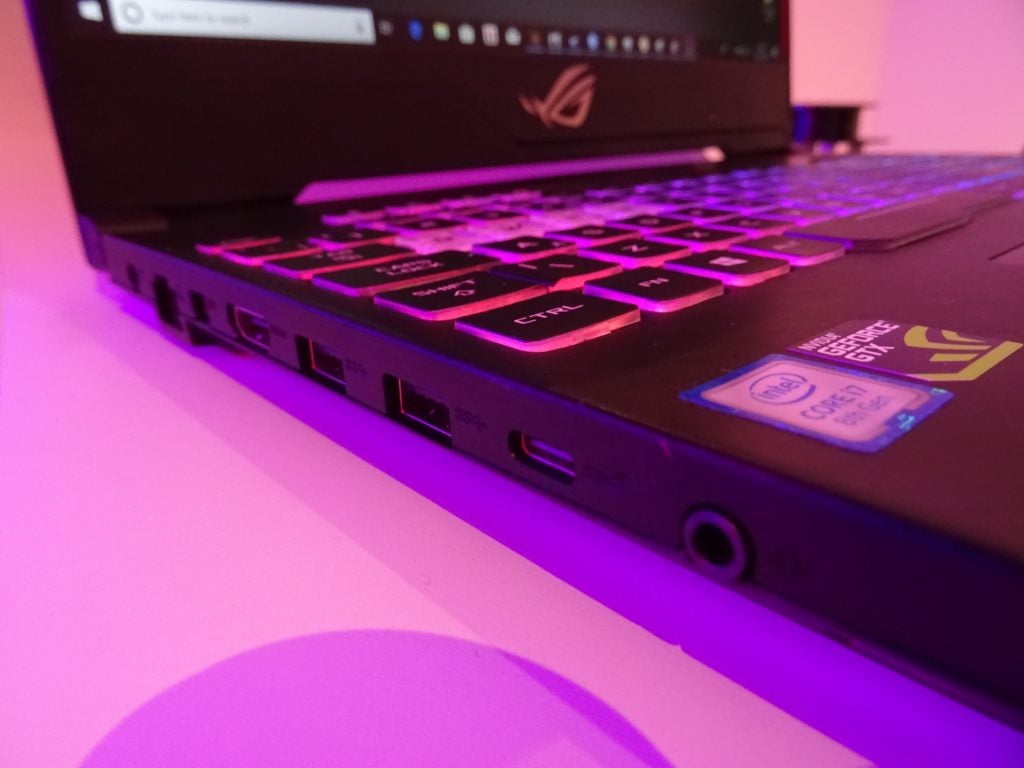
Gaming laptops tend to have more ports than Singapore, and the ROG Hero II is no exception.
Note that you’ll want to hook up the ROG Hero II to some speakers too, because the built-in units offer pretty poor bass response. They’re plenty loud, but low-end frequencies are muddy. I blasted “Master of Puppets” at my colleagues, and everyone in the room visibly winced once the bass starts to properly get going.
With the Bass Boost setting turned off (it’s turned on by default), low-end distortion is still audible – even at 30% volume. This was present on other tracks and game audio too, so it isn’t only 80s thrash bands who end up sounding terrible. You’ll obviously want to invest in a headset for gaming anyway. Regardless, I’m hoping the poor bass response was only an issue in this review model, and not the entire line.
In addition to the 3.5mm audio jack, the ROG Hero II treats you to a selection of ports that’s above and beyond what you’d get on a typical notebook or Ultrabook.
On the left there’s Ethernet, DisplayPort, HDMI, two USB-A ports, and a USB-C. Most of the space on the right is taken up by an air vent, but even so, you get an SD card reader, a third USB-A port and a security slot.
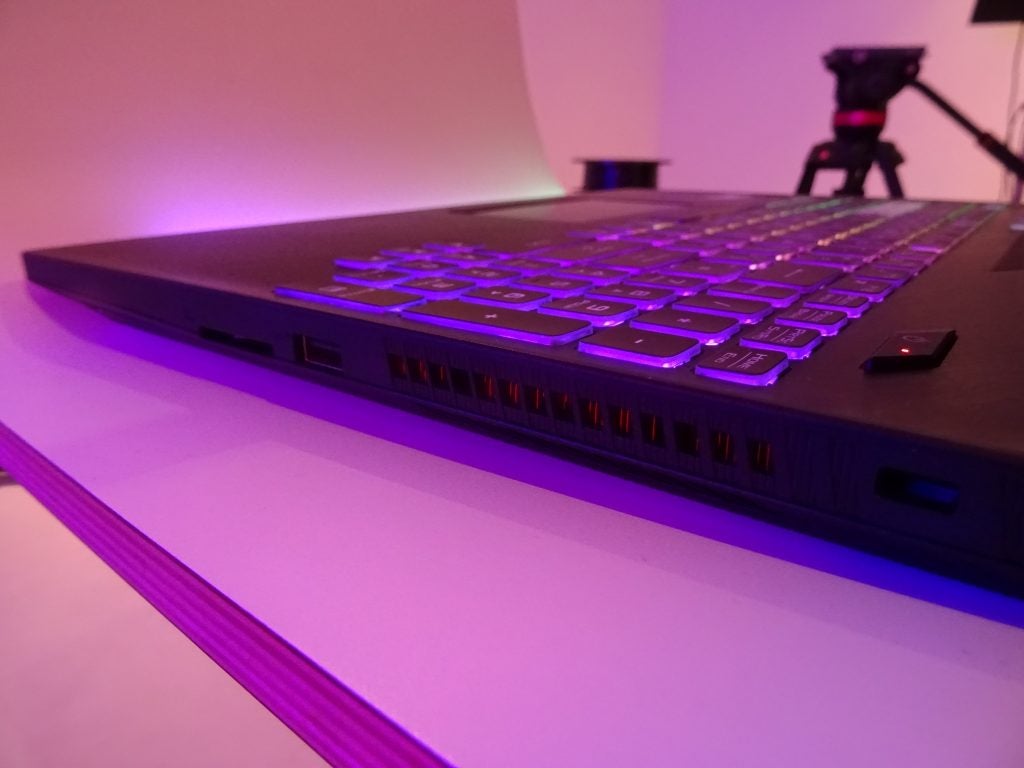
There are fewer ports over on the right-hand side of the ROG Hero II, as most of the space is taken up by an air vent.
Asus ROG Strix GL504 Hero II – Keyboard
Since the Asus ROG Strix GL504 Hero II is a gaming laptop aimed primarily at MOBA players, it’s the QWER keycaps that are highlighted here instead of the typical WASD keys used for most FPS games. Typically, these hotkeys are where your commands will be mapped, so you can quickly chug healing potions, mana boosts and the like.
There are dedicated hotkeys above the F1-4 keys for volume controls, mute and a ROG hotkey that launches the Gaming Centre dashboard. Here, you can tweak features such as the RGB lighting modes and check CPU and GPU temperatures.
The Fan Overboost feature lets you manually toggle whether the fan is either running quietly or running at maximum “Overboost” speed. You’d use this to accelerate the cooling of the ROG Hero II’s cores, which is useful if you’ve just come to the end of a gaming session and everything is running a little hot.
For the majority of the time you’ll want to stick to the default Balanced setting, which strikes a balance between the other two extremes and doesn’t see gaming performance dip.
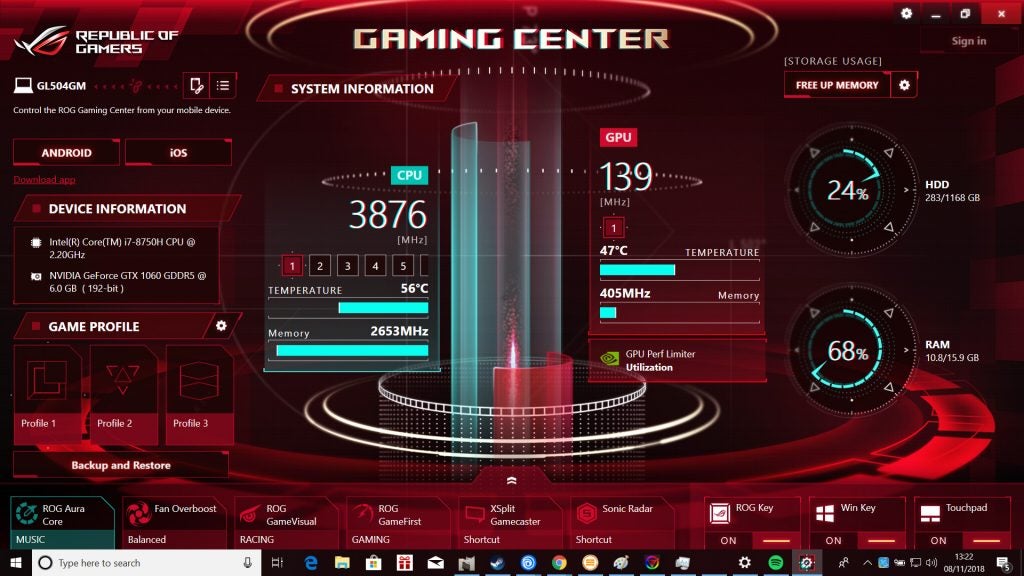
The Gaming Centre dashboard provides a quick look at CPU and GPU core temperature, lets you toggle fan speeds, game profiles and lighting modes.
There are modes for racing, FPS, and RTS/RPGs games, a Scenery mode (which generally boosts the brightness), Cinema mode, which dials down the contrast, and a default mode. These modes are cosmetic, and had no bearing on actual performance in my tests.
Aside from gaming, the keyboard is relatively well spaced for typing and getting your hands on those hotkeys. There’s a fair bit of travel, but this arguably makes for more precise typing/commands, and less fat-finger fumbles.
The chiclet-style keys don’t quite reach the same levels of typing nirvana afforded by the Dell XPS 15 2-in-1’s maglev setup, but they’re decent enough. You’ll have no issues working on this in-between gaming sessions.
On the downside, the numerical keys shunted over to the right are too tightly bunched for my liking, to the point where it’s a typo minefield. The arrow keys, in particular, are too small, and their positioning – as an inverse T-shape that’s tacked on to the number pad like a stray Tetris piece – is difficult to get used to.
The trackpad is super-responsive, while the left and right keys are big and chunky, offering a satisfying degree of travel. It’s a little smaller than the trackpads of the Razer Blade 15 and the Gigabyte Aero 15, but it never made my admittedly bigger-than-average hands feel claustrophobic.
Chances are you’ll want to splash out on a mouse anyway, so some of the trackpad limitations might not be a big issue.
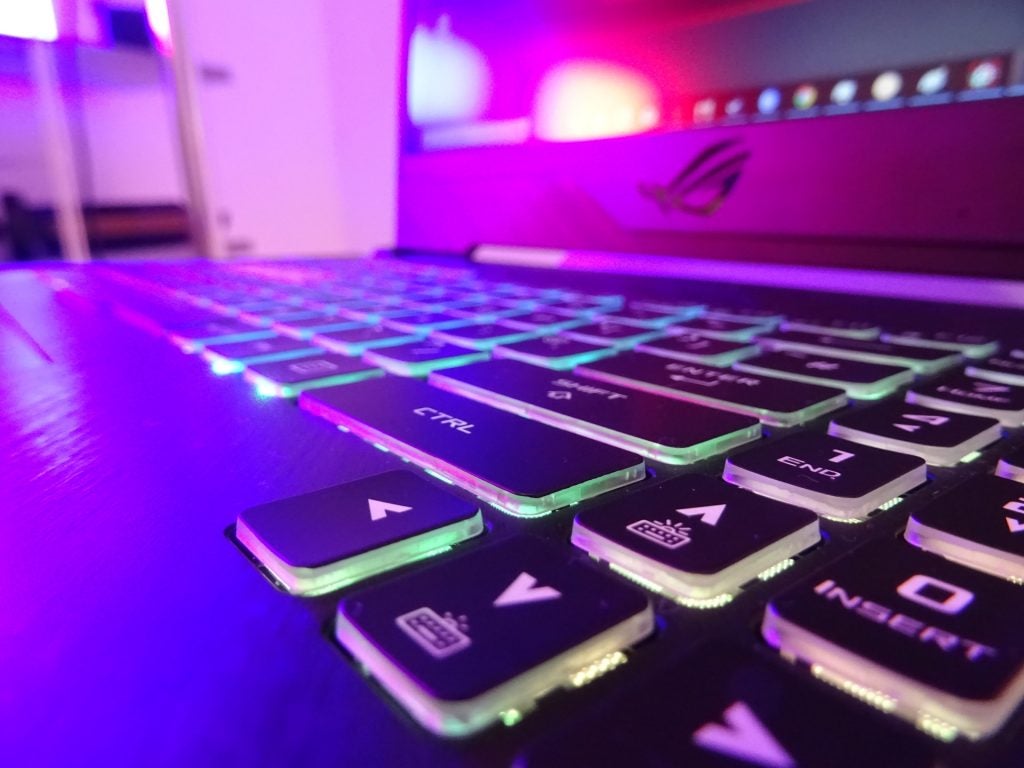
Like most gaming laptops, the ROG GL504 Hero II’s spartan black body is offset by polychromatic show-off lights.
Asus ROG Strix GL504 Hero II – Display
Two versions of the ROG Hero II are on sale, one with a 60Hz refresh rate and the other with 144Hz. The model we tested was of the latter version. It perhaps isn’t surprising that everything in general looks smooth. As MOBA-type games tend to be frantic and fast-paced, a high refresh rate will come in handy. Whichever model you pick, you’ll no doubt appreciate the super-skinny bezels, which are a hair’s breadth over 10mm.
Note that when I performed my screen tests, I also made sure the “default” mode was selected.
With the screen cranked to max brightness, I recorded a high of 342 nits with our colorimeter, and a good black level of 0.27 nits. I recorded a colour temperature of 7150K, which is quite a lot cooler than the ideal 6500K. Colours did on occasion look a little washed out, although this may have more to do with the reflective coating that sometimes catches ambient light in odd ways and limits the otherwise decent viewing angles.
Colour gamut coverage was respectable, but not exactly mind-blowing. The ROG Strix Hero II covered 84.8% of the sRGB colour space. The sRGB gamut is the world’s standard for digital and printed art. Anything above 80% is generally pretty good. However, if you were thinking about using this device for Photoshop work, there are far better options available.
Adobe RGB and DCI-P3 scores were low. I recorded coverage levels of 61.8% and 66% respectively. These colour gamuts are generally favoured by digital photographers. These scores aren’t ideal; generally if you’re working with photography, you’d want a display to offer 80% (or more) here.
The Razer Blade 15 and Gigabyte Aero 15 scored similarly in the latter two colour gamut tests, but both presented significantly better sRGB coverage – 92.6% and 97% respectively, proving that they’re easily the best choices for colour accuracy.
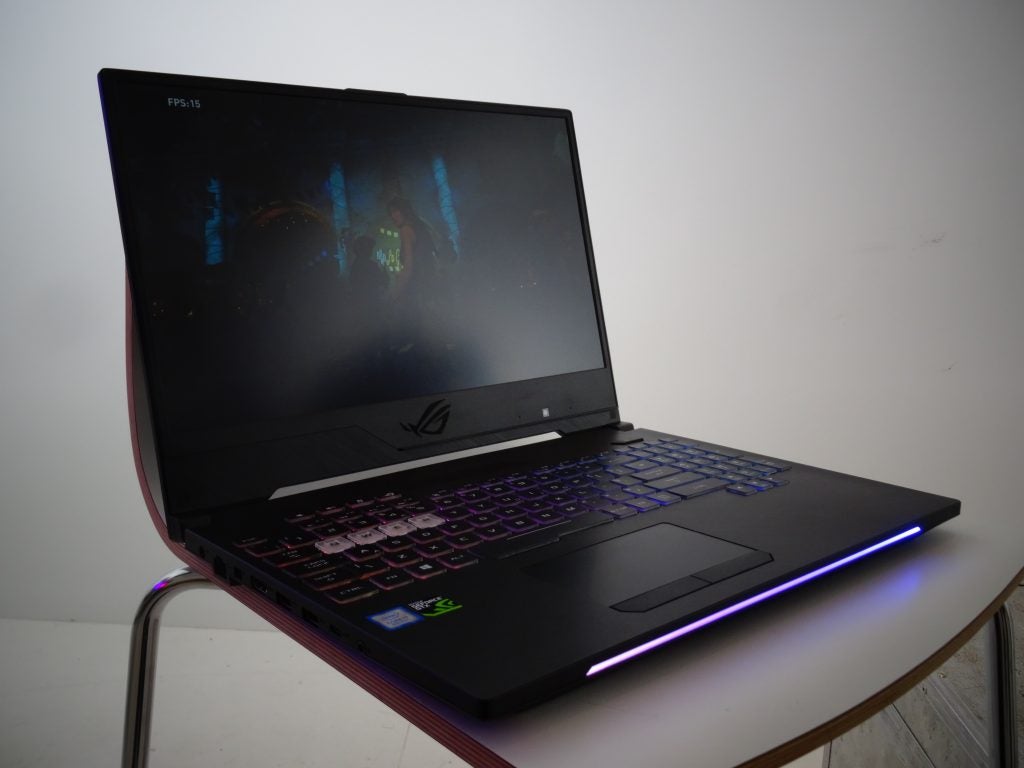
The viewing angles of the ROG Hero II are generally very good. Generally…
Asus ROG Strix GL504 Hero II – Benchmarks and performance
In terms of using the ROG Strix Hero II as a standard laptop, performance is on par with the likes of the LG Gram 14Z980 and Microsoft Surface Pro 6, which achieved similar Geekbench 4 and PC Mark 10 results.
Read and write speeds were low as well, although whether I was booting a game or moving large photo files around between phones, SD cards and an external drive, nothing felt too sluggish.
Here’s how I got on when putting the ROG Hero II through the standard Trusted Reviews benchmarking process:
| Asus ROG GL504 Hero II | |
| Geekbench 4 single-core | 4670 |
| Geekbench 4 multi-core | 17,092 |
| PC Mark 10 | 3169 |
| CrystalDiskMark read | 1291.5 MB/s |
| CrystalDiskMark write | 248.9 MB/s |
| Cinebench OpenGL | 86.45fps |
| Cinebench cb | 1209 cb |
| 3DMark Firestrike | 10,115 |
| 3DMark Firestrike Extreme | 5280 |
Since the ROG Hero II comes with a GTX 1060 built in, I ran the Fire Strike simulation in 3DMark, which is the Trusted Reviews standard test for laptops with dedicated graphics cards.
This gave me a result of 10,115, a little below the Razer Blade 15’s 11,624 and the Gigabyte Aero 15’s 12 894. However, this is to be expected, since the latter two come with more powerful GTX 1070 GPUs.
If you want a laptop or PC to play battle arena-type games then a GTX 1060 ought to provide sufficient power to deliver 60fps at 1080p Full HD. In the absence of a Dota 2 benchmark, I used Steam’s in-game fps counter. Most of the time, I found that I’d comfortably hit 80fps and above when there wasn’t much happening on-screen, and around 60-80fps during intense battles, on the highest possible video settings.
I picked a range of other games for my tests – including Shadow of the Tomb Raider and Ghost Recon Wildlands – to see how modern-day solo and multiplayer games might fare on the ROG Hero II. I also tested a couple of older titles, Dirt Rally and Middle-earth: Shadow of Mordor.
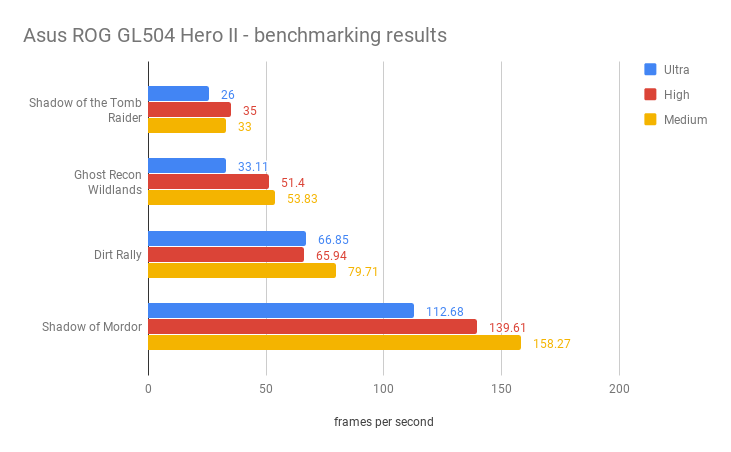
Pushing some games – Shadow of the Tomb Raider in particular – up to High and Ultra settings saw quite a jittery performance. On occasion, Tomb Raider and Ghost Recon would dip to 15-20fps, which is really not ideal.
Given that the ROG Strix Hero II has a 1080p display and a last-gen GPU, it clearly isn’t aimed at bleeding-edge gamers who want to get into 4K gaming – although the 144Hz screen option is a nice feature, especially when playing old games such as Shadow of Mordor that see frame rates soar above the 100-mark.
You’ll want to have the fan mode set to Balanced when gaming. All the above results were recorded with this fan mode switched on. You might think that cranking up the fan speed to max in order to lower component temperature will work, but in my experience, this actually resulted in frame rate dips of around 20fps. This setting is intended to be used between gaming, not during.
Asus ROG Strix GL504 Hero II – Battery
It’s usual for gaming laptops to be relatively poor in the battery department, and the ROG Strix Hero II doesn’t buck the trend.
Using Powermark to loop 10 minutes of browsing and five hours of video, the ROG Strix Hero achieved a result of 3hrs 44mins. This is a somewhat middling score for gaming laptops, which tend to offer at worst two hours of unplugged action or at the very best around five hours.
For day-to-day, non-gaming use I found the ROG Strix Hero II would survive a little over four hours before needing to be plugged in – so a little more than the Powermark score implies. Gaming was another matter entirely. Playing Tomb Raider at Medium settings, I managed just over an hour before the ROG Hero II started flashing warning messages at me.
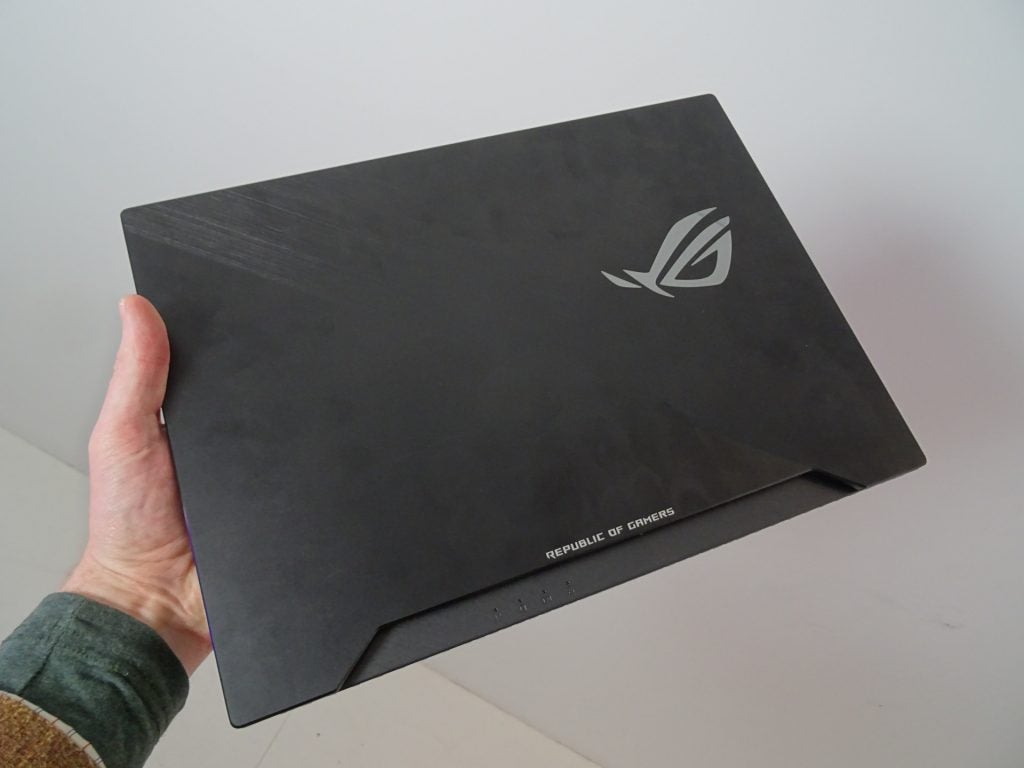
I might be holding the ROG Hero II in one hand here, but trust me, this thing is pretty heavy.
Asus ROG Strix GL504 Hero II – Specifications
| Asus ROG Strix GL504 Hero II | |
| Dimensions | 361 x 262 x 26.1mm |
| Weight | 2.4kg |
| Processor | Intel Core i5 8300H/Core i7-8750H (tested) |
| Memory | Up to 32GB |
| Graphics | Nvidia GeForce GTX 1060 (6GB GDDR5 vRAM) |
| Storage | M.2 NVMe PCIe 128GB/256GB/512GB SSD, 1TB HDD/1TB SSDH |
| Display | 15.6-inch Full HD IPS 3ms (60Hz)/15.6-inch Full HD IPS 3ms (144Hz) |
| Connectivity | 802.11ac 2×2 Wi-Fi, Bluetooth 5.0 |
| Ports | Ethernet, USB-C 3.1 (Gen 2), USB-A 3.1 (Gen 2), USB-A 3.1 (Gen 1), mini-DisplayPort 1.2, HDMI 2.0, 3.5mm audio jack, SD card port, Kensington lock |
| Cameras, mics and speakers | 720p HD camera, 2 x 3.5W SmartAMP speakers, array microphones |
| Misc | VR Ready, Asus Aura Sync RGB lighting, marked QWER keys, |
Why buy the Asus ROG Strix GL504 Hero II?
The ROG Hero II offers underwhelming frame rates for modern AAA games, especially when you consider that the likes of the Dell G5 offer a superior performance for a significantly lower price.
But to compromise, you’re getting a 144Hz display with the ROG Hero II. You’ll do very well indeed to find a gaming laptop boasting a better refresh rate at a cheaper price. Sure, the ROG Hero II will struggle to offer a smooth performance for recent triple AAA games such as Shadow of the Tomb Raider and Ghost Recon Wildlands, but less intensive games will benefit significantly thanks to the 144Hz display.
So if you’re content with sticking to the likes of Dota 2 and older iterations of Call of Duty, then the Asus ROG Hero II offers great value for money.
Verdict
One of the cheapest gaming laptops you’ll find with a 144Hz display, but rival options offer superior performances for less cash.
How we test laptops
Unlike other sites, we test every laptop we review thoroughly over an extended period of time. We use industry standard tests to compare features properly. We’ll always tell you what we find. We never, ever, accept money to review a product.


